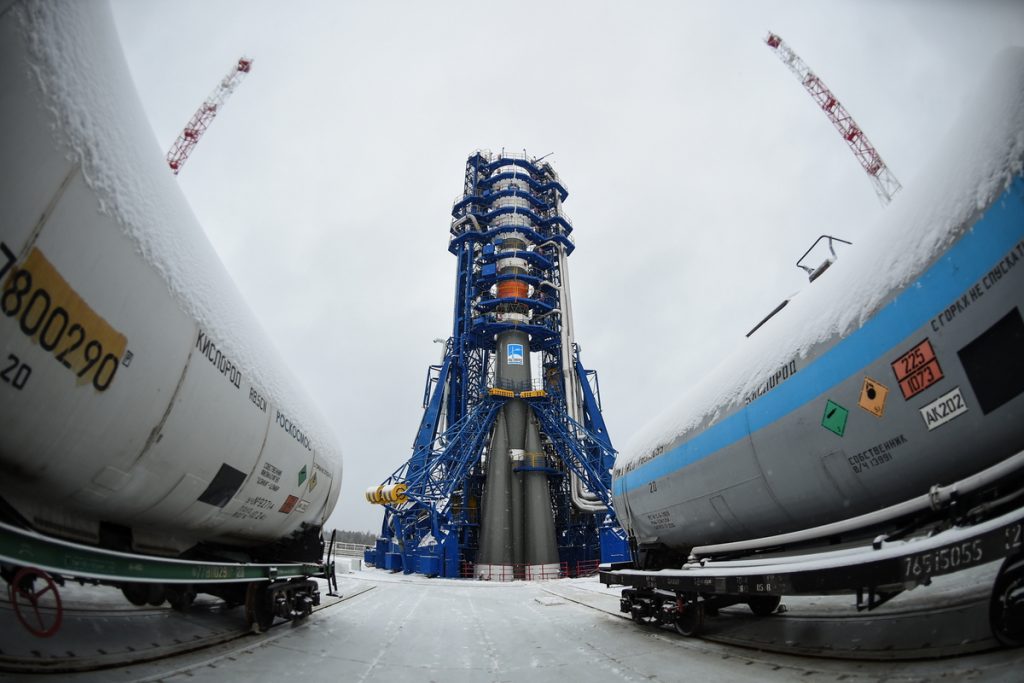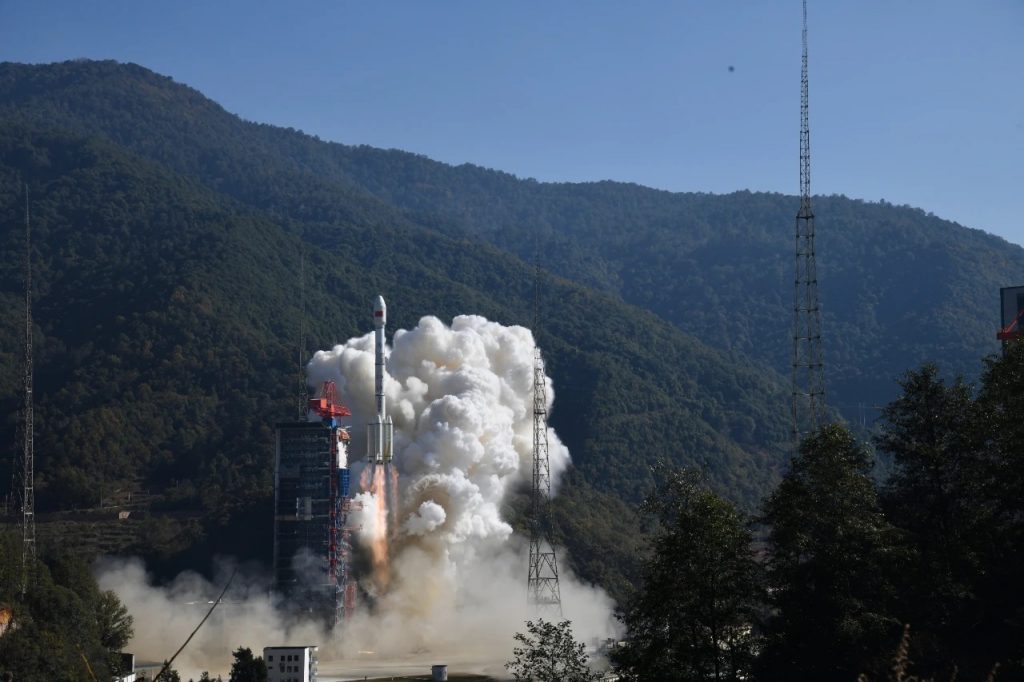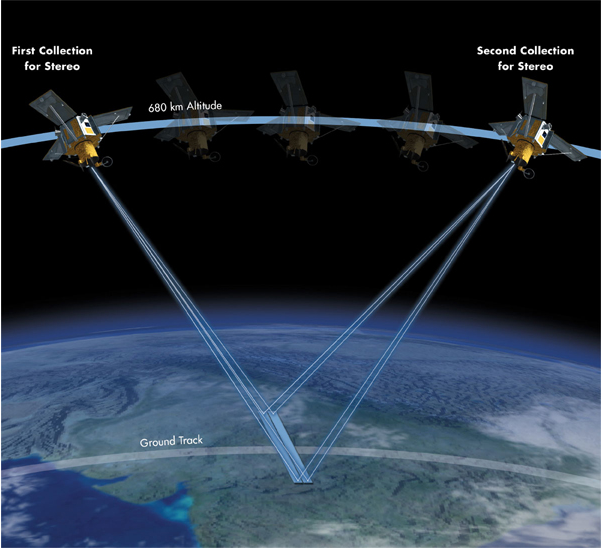Media
Summary
Join us for this week’s Rocket Roundup with host Annie Wilson as we look back at the launches that happened from the past week, including a Soyuz, a Long March 3B, and a Falcon 9.
Transcript
Hello, and welcome to the Daily Space for today Wednesday, December 9th, 2020. I am your host Annie Wilson. Most weekdays we’re here putting science in your brain.
Usually, Wednesdays are for Rocket Roundup and today is no different, so let’s get to it, shall we?
First up, at 01:14 UTC on December 3rd, a Russian Military Soyuz-2.1b was launched from LC-43/3 at the Plesetsk Cosmodrome in northern Russia. Onboard were four satellites, a trio of Gonets satellites, and a small military satellite. “Gonets” means “messenger” or “courier” in Russian.

The Gonets trio joins an existing constellation of at least twelve other Gonets satellites already in operation. Together, the Gonets constellation will continue to provide “store and dump” communication services for areas that can’t receive a cellular signal. Basically, terminals in the network ping the satellites periodically to let them know they are available for transmission, then the satellites transmit any stored data intended for that terminal. This is in contrast to most commercial communications satellites which don’t store any data aboard but re-transmit it back to the Earth as soon as it is received.
Current uses of the Gonets network include sending and receiving messages or data globally — including pump stations for gas and oil pipelines, tracking cargo containers on ships, and communications for humans in really remote areas.
According to Roscosmos, the passenger satellite, ERA-1, is a “nanoscale service platform developed for the Russian Defence Ministry, designed for testing advanced micro-devices and orientation and astrogation microsystems.” No other information was released about the smallsat.
As expected, there was no live broadcast. Head of Roscosmos Dimitri Rozgozin later confirmed via Twitter the satellites were in orbit.
Next up, on December fifth at 03:58 UTC, China launched a Long March 3B from LC-3 at the Xichang Satellite Launch Center in southwestern China. Onboard was Gaofen-14, the next in China’s series of high-resolution optical imaging satellites.

This particular Gaofen-14 satellite is an optical stereo imaging satellite. This means that the satellite takes two images of the same target from different angles. When the images are processed, it is possible to extract elevation from the data, which can be used for topographic mapping and the creation of digital elevation models.
Our last launch of the week was a SpaceX Falcon 9. On December sixth at 16:17 UTC, CRS-21 started its journey to the International Space Station from historic LC-39A at Kennedy Space Center, Florida.
CRS-21 marks the first flight of a Dragon 2 as a cargo resupply ship. Cargo Dragon 2 features a different pressure vessel than Crew Dragon, so although the two craft share a name, they aren’t the same — Cargo Dragon 2 doesn’t carry people, so there’s no need for things like windows or an abort system. As far as upgrades from Cargo Dragon 1, the newer craft has twenty percent more volume and ditches the extendable solar panels for wrap-around panels on one side of the trunk. On the other side of the trunk are radiators. Additionally, Cargo Dragon 2 docks itself to the space station without assistance from Canadarm2. The IDA-3 docking adapter CRS-21 docked to was itself brought up in the trunk of the CRS-19 Dragon in July 2019.
The primary payload for CRS-21 was the Bishop airlock — the very first commercial airlock on the ISS. Built by NanoRacks, Thales Alenia Space, and Boeing, it will be used to deploy CubeSats from the ISS more efficiently.

The current method involves using an equipment airlock in the Japanese Kibo module, but it is low capacity. That particular airlock only opens ten times a year, with half of those instances reserved for JAXA, Japan’s space agency, and the other half allotted to NASA and commercial partners.
Bishop will be attached to Node-3 port. Also on Node 3 is the Cupola module and the Bigelow Expandable Activity Module. Also onboard were supplies for the crew and new science experiments.
For those of you keeping score at home, this was the fourth flight for B1058. There were two firsts for NASA with this mission: this booster previously flew a non-NASA mission and it has flown more than once. It had a successful landing on Of Course I Still Love You. Unlike a Falcon 9 with a satellite payload, there were no fairings used for this Dragon launch and therefore none were recovered.
This new version of Cargo Dragon, like the Crew Dragon it is based on, has a hinged cover to protect its docking port that is retracted once on orbit to allow docking. The four Draco thrusters used for deorbit are also under this cap. It is folded back after this burn and before it enters the atmosphere, to protect the docking port.
So, I mentioned that the Gaofen-14 satellite is an optical stereo imaging satellite. I wasn’t really sure what that was, so I asked Gordon, aka Keeper of Maps. The following is his explanation.
Most people have stereoscopic vision, meaning that they can see in three dimensions and thus discern where things are located spatially. This is because their eyes are slightly separated horizontally. Each eye sees a slightly different image, but the brain combines the two images allowing one to perceive three dimensions.
This can be done with photographs too. In the early days of photography, stereoscopic images were created by special cameras with a pair of lenses next to each other. The resulting image was printed on a card that when viewed through a stereoscope could be viewed in 3D.

This is what a stereograph looked like circa 1908. The two images are similar but not identical. The parallax means that objects closer to the camera will appear in slightly different positions relative to the objects behind them.
Amusingly, this stereograph is of someone looking at a stereograph with a stereoscope in their sitting room.
This is a picture of a Holmes stereoscope, which was the most popular type of stereoscope in the nineteenth century. It allowed the left eye to view the left image while the right eye viewed the right image. The geometry was such that it tricked the brain into thinking it was looking at a real scene and not just a couple of photographs.
Jumping forward a few years to 1939 (yes, really), the View-Master appeared on the scene. It underwent small changes over time to become the iconic red gadget that you put little cardboard disks with tiny slides.
Jumping forward a few more years to the late 1980s/early 1990s, virtual reality headsets appeared on the scene that allow the wearer to view three-dimensional images that react according to the direction that they’re looking. The technology has changed a lot since they first appeared and now you can pick one up for a relatively small amount of money compared to what the first ones cost.
They’re used for all sorts of applications from medical training, military training, gaming, and remote sensing.
Remote sensing is observing something from far away. Before satellites, aerial photographs, taken from airborne platforms such as airplanes, balloons, and even kites, were used to create stereographic images which cartographers could use to create topographic maps via stereogrammetry techniques, also known as photogrammetry.
The same basic techniques can be used with satellite imagery, and even radar data, which is called radargrammetry.

This image shows how the IKONOS satellites operated by Satellite Imaging Corporation collect stereographic images from low earth orbit. The data can be used for a variety of applications, such as detecting changes due to erosion or earthquakes, or some other natural process. For example, you could compare the three-dimensional profiles of a volcano over time to identify small changes caused by a buildup of magma underground. If the three-dimensional profile of a volcano starts changing, this could be an indicator that an eruption is going to take place.
I hope this explained what stereoscopic imaging is, how it is collected, and a few examples of what it is used for.
If you enjoy this kind of in-depth explanations, let us know and we’ll try to find other topics to explore.
To wrap things up, here’s a running tally of a few spaceflight statistics for the current year:
Toilets currently in space: 5 — 2 installed on ISS, 1 on the Crew Dragon, 1 on the Soyuz, 1 not yet installed
Toilets burned up: 3
Total satellites humans put into orbit: 1178 (includes those launched from other in-orbit craft, such as the ISS)
Total satellites from launches: 1147
Total Starlinks (this year): 833
Total 2020 orbital launch attempts: 103 (including 10 failures)
I keep track of orbital launches by where they launched from, also known as spaceport. Here’s that breakdown:

China: 36
USA: 34
Kazakhstan: 7
Russia: 6
French Guiana: 6
New Zealand: 6
Japan: 4
Iran: 2
India: 1
Israel: 1
Your random space fact for the week is that there are 100 $2 bills on the Moon. They were left in the lunar module by the crew of Apollo 15.
Learn More
Second successful launch of Soyuz-2 rocket in 24 hours
- Roscosmos press release
- Russian Spaceweb article
- Russian News Agency article
- NASA Spaceflight article
- ERA 1 info page (Gunter’s Space Page)
- Gonets-M info page (Gunter’s Space Page)
China launches Gaofen-14, another Earth-observation satellite
- CASC press release
- CGTN article
- Gaofen-14 info page (Gunter’s Space Page)
SpaceX launches twenty-first Commercial Resupply Services mission
Credits
Host: Annie Wilson
Writers: Gordon Dewis, Beth Johnson, Erik Madaus, Ally Pelphrey, and Annie Wilson
Audio and Video Editing: Ally Pelphrey
Content Editing by Beth Johnson
Executive Producer: Pamela Gay
Intro and Outro music by Kevin MacLeod, https://incompetech.com/music/


 We record most shows live, on Twitch. Follow us today to get alerts when we go live.
We record most shows live, on Twitch. Follow us today to get alerts when we go live.